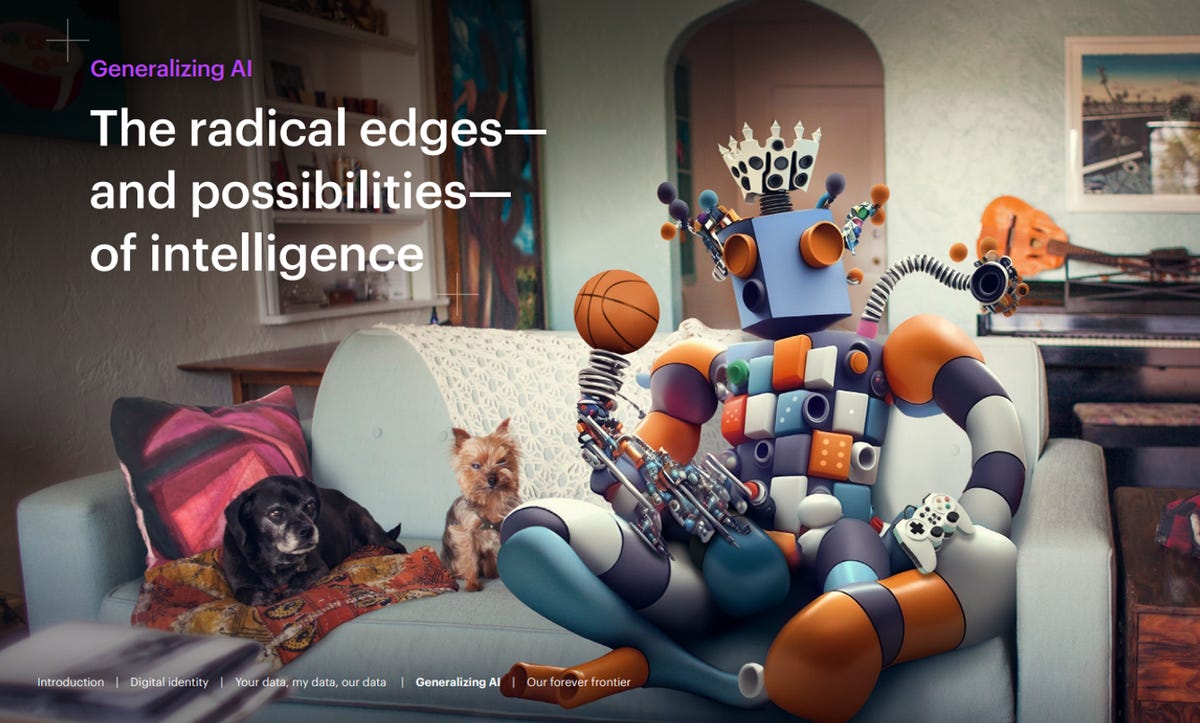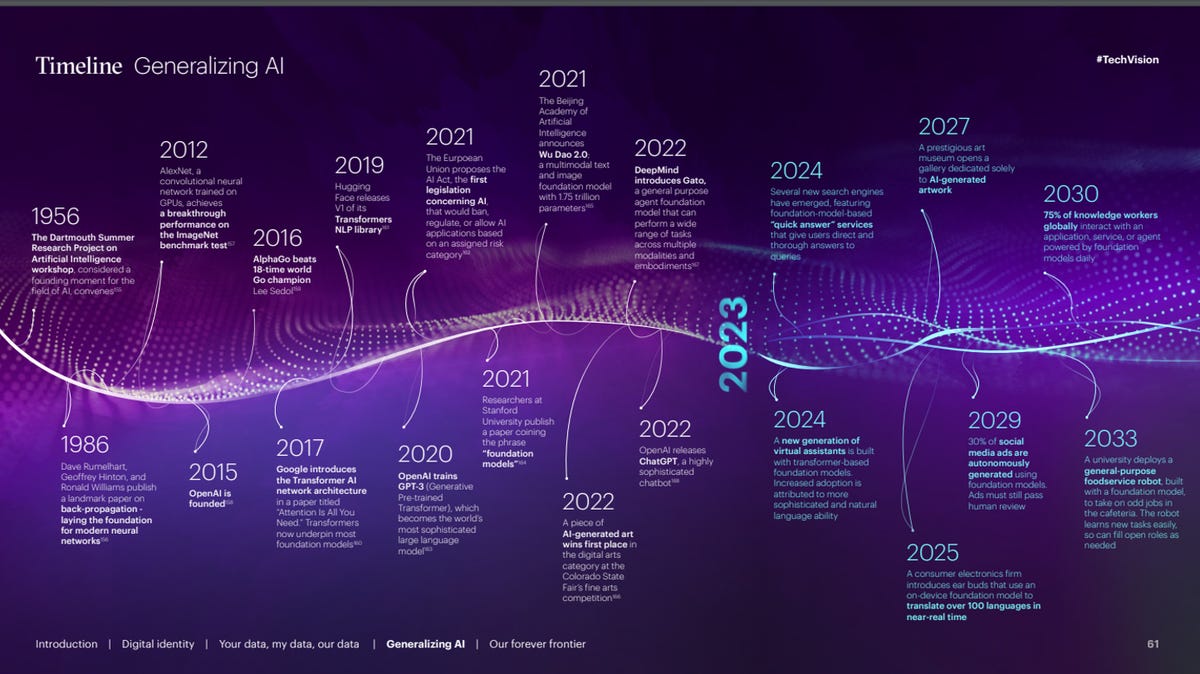Every business is a digital business. Yet Accenture shows that only 8% of companies are adopting a total business reinvention strategy.
In the Accenture Technology Vision 2023 Report, the company’s researchers examine the shift from the physical to the digital world. The report reveals that 96% of executives say the convergence of the digital and physical worlds over the next decade will transform their industry.
Given that our digital and physical worlds can seem disconnected and disjointed, it’s no wonder that the innovation efforts of the next decade will be defined by how we merge the two. An example of this merger is the growing trend of cobots (collaborative robots), a market that is expected to reach $16.3 billion by 2028.
Accenture’s report explores technology trends and the steps businesses will need to take to thrive. The four technology trends of 2023 are:
- Digital identity – identification for everyone and for everything. Digital identity is becoming key to enterprise technology aspirations, and efforts to reimagine it are underway — not just for people, but for all things.
- Your data, my data, our data. Transparency will become your most valuable resource. Data ecosystems are being reshaped by radical transparency, with companies leveraging their data to deliver unprecedented insights into their business.
- Generalizing AI – The limits and radical possibilities of intelligence. AI training models are driving one of the biggest changes in the history of Artificial Intelligence. Now business leaders can go from building their own AI to building with AI.
- New frontier – The big bang of computing and science. After decades of hyper-focus on digital technology, science is returning to the top of business priorities.

Accenture Technology Vision 2023 Report
This article focuses on the technology trend of widespread AI. Here is an overview of the main conclusions regarding the limits and possibilities of AI.
The wave of AI-generated content is so advanced that it is now part of one of the biggest changes in AI history: the introduction of preformed models with remarkable task adaptability that will revolutionize how and where businesses in all industries use AI.
The report notes:
It started with a landmark innovation in the architecture of AI models by Google researchers in 2017. Since then, tech companies and researchers have supersized AI, increasing the size of models by 10,000 and training sets as well. The result: powerful pre-trained models, often referred to as “basic models“, which offer unprecedented adaptability in the domains on which they are trained, be it language, images or protein structure. Thanks to this adaptability, the basic models can accomplish a wide variety of tasks without the need for specific training.In addition, companies that create basic models allow third parties to access them through APIs or open sources, which puts these advanced models within reach. of all.
A study by Accenture reveals that 96% of executives are very inspired by the new capabilities offered by AI models.
A new class of AI
In order to define this new class of AI, researchers at the Stanford Institute for Human-Centered Artificial Intelligence coined the term “base model” in August 2021, which they generally define as large AI models trained from large amount of data and highly adaptable to downstream tasks.
In practice, these models are usually based on Transformer machine learning models (also called Transformer, and this is important since it is the T of GPT) and include a considerable number of parameters, ranging from hundreds of millions to trillions. The game-changer is that they are largely trained in one data modality (or multiple modalities like language and image), rather than a specific task, and can learn to perform new tasks in these types of data with minimal additional training, or no training at all. In other words, they have generalist capabilities in their field.

Chronology – Generalization of AI. Accenture Technology Vision 2023 Report
AI Base Model Operation and Progress
One of the newest classes of AI models, transformers, are neural networks that identify and track relationships in sequential data (like the words in a sentence), in order to learn how they depend on each other. others and influence each other.
Stanford’s 2022 Artificial Intelligence Index Report found a significant uptick in the annual number of global AI publications since 2017. According to CB Insights, 2022 saw record investment in generative AI startups, with 2.6 billion dollars in financing through 110 transactions. The research found that 97% of world leaders agree that AI foundation models will enable connections between data types, revolutionizing where and how AI is used.
To fully understand the impact that baseline models will have on their industries and businesses, companies need to carefully monitor new developments. The amount of computation needed to train the largest AI models has increased exponentially – it now doubles every 10 months to every 3.4 months, according to various reports.
The business implications of AI-generated content
The question facing companies today is not whether these models will have an impact on their sector of activity, but how.
Foundation models are widely adaptable and could technically be used for a wide variety of tasks – so it’s in the decisions companies make about where and how to deploy them, what problems to try to solve with them, and what problems to address. with other technologies, that lies the competitive differentiation.
An example of how base models are changing the interaction between humans and artificial intelligence is transforming the way work is done. Google used a basic model to develop a code completion tool, which more than 10,000 engineers tested for three months. The results showed that the coding iteration time was reduced by 6%.
From building AI to building with AI
Large tech companies and research organizations that have built basic pre-trained models are beginning to position them as platforms to underpin new AI applications. They make base models available through open-source channels or through paid access through APIs – meaning downstream organizations don’t need to build their own base models, but can focus on construction from existing models.
Core models evolve the conversations of “How do I build my own AI?” to “What can I build with AI?” In fact, 98% of global leaders agree that AI core models will play an important role in their organizations’ strategies over the next 3-5 years. Eventually, AI operations will shift from building models to building on top of models.
AI-driven work and life transformation
Once companies have determined where to use the core templates, they will then need to decide how they will access these templates and where they fit into the core template ecosystem. For example, another layer of the ecosystem will be formed by companies that access base models through APIs or model repositories and rely on these models to build their own applications and services.
A specialist recruitment strategy will have to be defined and constantly adapted. Whether it’s training every employee in the capabilities of the core models or creating dedicated teams to integrate these models into different parts of the business, it’s essential to bring the entire organization into in this new era of AI.
The Accenture Technology Vision 2023 report concludes with the following: “The arrival of foundation (or base) models is one of the biggest changes in the history of AI – and no company can ignore them. These supersized models, with unprecedented adaptability to new tasks, are forcing companies to rethink their AI strategies – from how they access AI to what applications are even possible.”
Businesses are able to use these basic templates now. This landscape is changing rapidly and the opportunities will continue to develop rapidly. AI is the electricity of the 21st century – if you ignore it, your business will remain in the dark.
To learn more about the Accenture Technology Vision 2023 report, click here.
Source: “ZDNet.com”
